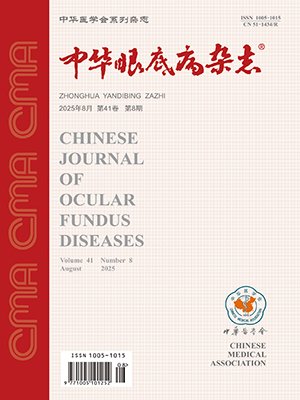Objective To investigate the clinical features of polypoidal choroidal vasculopathy (PCV) in Chinese patients.Methods The clinical data of 71 continuous patients (142 eyes) who were diagnosed with PCV by fundus photography, fundus fluorescein angiography (FFA), indocyanine green angiography (ICGA) and optical coherence tomography (OCT) were analyzed retrospectively.Results Eleven patients (11 eyes) of 71 patients (142 eyes) were diagnosed with PCV to make up 15.49% and 7.75% of the numbers of patients and affected eyes respectivery. The patients included 7 males (63.6%)and 4 females (36.4%). The predominant location for these lesions was the macular region in 10 eyes (90.9%). Fundus examination demonstrated the reddish-orange nodular elevations in 6 eyes. ICGA revealed umbrellalike or twiglike branching vascular networks and polypoidal dilations at the vascular terminals of the branches in all patients, and feeder vassels within choroidal vascular networks were found in 8 eyes. OCT images of retinochoroidal structures showed prominent anterior protrusion of the orange subretinal mass corresponding to the polypoidal structure in the indocyanine green angiogram. An apparent discontinuity was observed in the highly reflective layer which delineates the polypoidal structure.Conclusions PCV mainly affects the male over 50 years and the eyes involved were mostly unilateral. Most of polypoidal vascular lesions are present in the macul ar area. (Chin J Ocul Fundus Dis,2003,19:269-332)
Citation: CAI Shanjun,TANG Jian,ZHAO Yingjie.. The clinical features of polypoidal choroidal vasculopathy. Chinese Journal of Ocular Fundus Diseases, 2003, 19(5): 273-276. doi: Copy
Copyright © the editorial department of Chinese Journal of Ocular Fundus Diseases of West China Medical Publisher. All rights reserved




